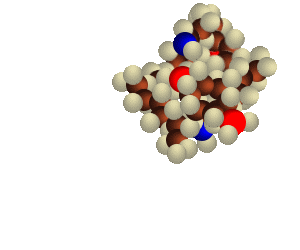|
|
 |
|
|
|
 |
 |
|
|
 |
Context
|
Key words:
evaporation, condensation, saturation, particle formation | |
 |
 |
|
1. SOLID - LIQUID - GAS
Matter can have three different states.
graphic: adopted from NASA
|
We know that water and other chemical compounds can change their state of aggregation. Ice turns into liquid water at the melting point, liquid water into water vapour at the boiling point. We also know that water can evaporate at much lower temperatures than the boiling point. Chemical compounds in the atmosphere do not only change their physical state, but they also react chemically. It is possible in the air that a chemically formed compound in the gas phase would normally be solid at the given temperature. What happens to such compounds, which have a by far lower vapour pressure and higher boiling point than water?
|
 |
 |
 |
|
2. Condensation of humid air in higher and cooler altitudes leads to cloud formation and sometimes rain.
Click the image for high resolution! (325 K)
© Earth Science Australia
|
|
Such single molecules do not immediately fall to the ground but float in the air and may collide with other big molecules, stick to them and form a pair of molecules. This may meet other big molecules, that merge with the group and finally form a cluster. The first step of 'nucleation' and particle formation took place. We could say, it is a process of resublimation or condensation, but it is a bit more complicated, since different chemical species can be involved.
If large solid or liquid groups of molecules float in the air, we call them particles or aerosols. If they consist of solid or liquid water, we call them not aerosol but ice crystals or droplets. The smaller the particles are, the longer they can stay in the air before falling to the ground. We are always surrounded by liquid or solid particles floating in the atmosphere.
|
 |
 |
 |
|
3. Soot particles collected on a filter (the big black holes are filter pores).
Not all particles form chemically in the air. Some solid matter is also directly released to the atmosphere: dust from sand storms, soot from cars, salts from evaporating sea spray.
Click on the picture, in order to see a larger view! (80 KB)
© Max Planck Instiute for Chemistry Mainz - AG Helas
|
|
 |
 |
|
4. a) Two water (H2O) molecules colliding in the atmosphere can hardly stick to each other, because they have much energy, symbolised by the yellow arrow, that cannot be transmitted to another body.
|
|
 |
Air can take up evaporating water as the humidity increases. Air of a certain temperature can take up a certain maximum of water and then it is saturated. The relative humidity at this point is 100%. The cooler the air is, the less water it can hold. This means if very humid and warm air rises to higher and cooler altitudes the saturation point can be exceeded, condensation takes place and clouds can form (see fig. 2). But clouds do not form from water only.
|
 |
 |
|
4. b) If water molecules collide with a particle this energy can be converted to a little vibration or deformation of the particle. The water molecule sticks more easily on the surface.
Animation: © Elmar Uherek
|
|
 |
Water molecules take up a lot of energy during evaporation. If they collide in the air, although it is saturated, they have too much energy in order to stick to each other. Neither molecule can get rid of its energy in such a collision, and they separate again. In absolutely particle free air, clouds even would not form if the saturation would be 200%. But in reality air always contains particles. Water molecules collide with a particle, release much of their energy to the big particle and stick to its surface. More and more water molecules do the same and surround the particle in the end with a layer of water. A droplet is growing. Many droplets form fog and clouds.
|
|
 |
|







